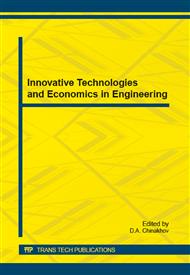[1]
Belyj A.V., Karpenko G.D., Myshkin N.K. Struktura i metody formirovanija iznosostojkih poverhnostnyh sloev. - M.: Mashinostroenie, 1991. - 208 s. [In Russian].
Google Scholar
[2]
Bajati M.R., Molei R., Zhanhorban K. Poverhnostnoe legirovanie uglerodistyh stalej iz jelektroliticheskoj plazmy / Metallovedenie i termicheskaja obrabotka metallov, 2011, №2 (668), s. 42-45. [In Russian].
Google Scholar
[3]
Zabelin S.F. Ob akktivacii i kineticheskoj teorii processov diffuzionnogo nasyshhenija metallov pri himiko-termicheskoj obrabotke / Materialovedenie, 2004, №7, s. 17-22. [In Russian].
Google Scholar
[4]
Saraev Ju.N., Shtercer A.A., Orishin A.M., Il'jushenko A.F., Skakov M.K. Kompleksnyj podhod k povysheniju jekspluatacionnoj nadezhnosti detalej i izdelij / Tehnologija mashinostroenija, 2011, №8, s. 39-42. [In Russian].
Google Scholar
[5]
Suminov I.V., Belkin P.N. i dr. Mir materialov i tehnologij. V 2-h tomah, Tom 1, M. izd. Tehnosfera, 2011, - 464 s. [In Russian].
Google Scholar
[6]
Gupta P., Tenhundfeld G., Daigle E.O., Ryabkov D. Electrolytic plasma technology: Science and engineering – an overview / Surf. &Coat. Technol. 2007.V. 25. P. 8746.
DOI: 10.1016/j.surfcoat.2006.11.023
Google Scholar
[7]
Duradzhi V.N., Himiko-termicheskaja obrabotka metallov s nagrevom v jelektrolitnoj plazme / ActualConference. Tehnologii obrabotki poverhnosti, 6 (69), 2010 g – s. 45-50. [In Russian].
Google Scholar
[8]
Belkin, P. N. Jelektrohimiko-termicheskaja obrabotka metallov i splavov Tekst. / P. N. Belkin. M.: Mir, 2005. - 336 s. [In Russian].
Google Scholar
[9]
Gol'dshtejn M.I., Grachev S.V., VekslerJu.G. Special'nyestali. – M.: Metallurgija, 1985. – 408s. [In Russian].
Google Scholar
[10]
Skakov M.K., Rakhadilov B.K., Rakhadilov M.K. Sposob uprochneniya rabochej poverkhnosti rezhushhego instrumenta ehlektrolitno-plazmennym nagrevom / Stanochnyj park, 2013 - №6(105). - S. 30 -33. [In Russian].
Google Scholar
[11]
Novye idei o mehanizme obrazovanija strukturyazotirovannyh stalej /S.A. Gerasimov, A.V. Zhiharev, E.V. Berezina, G.I. Zubarev /MiTOM, - 2004. № 1. - S. 13-17. [In Russian].
Google Scholar
[12]
Arzamasov B.N., Bratuhin A.G., EliseevJu.S., Panajoti T.A. Ionnaja himiko-termicheskaja obrabotka splavov.M., izd-vo MGTU im.N. Je. Baumana, 1999, 400 s. [In Russian].
Google Scholar
[13]
Usmanov K.B., Yakunin G.I. Vliyanie vneshnikh sred na iznosistojkost' rezhushhikh instrumentov. – Tashkent: Fan UzSSR, 1984. 160 s. [In Russian].
Google Scholar


